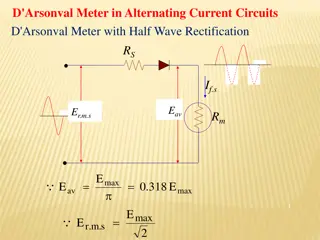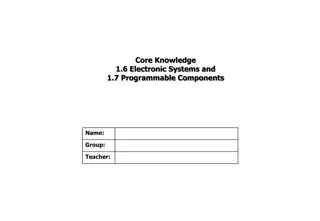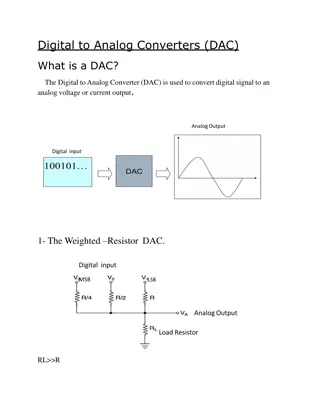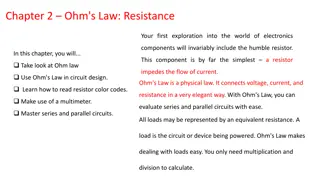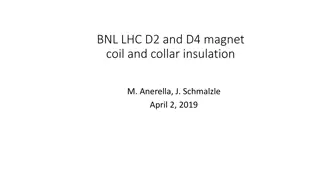
Identifying Resistor Values using Colour Code & Printed Code
"Learn how to determine resistor values using the Resistor Colour Code and the BS1852 Resistor Printed Code. Understand the significance of resistor markings, tolerance, and precision. Examples provided for easy comprehension."
Download Presentation

Please find below an Image/Link to download the presentation.
The content on the website is provided AS IS for your information and personal use only. It may not be sold, licensed, or shared on other websites without obtaining consent from the author. If you encounter any issues during the download, it is possible that the publisher has removed the file from their server.
You are allowed to download the files provided on this website for personal or commercial use, subject to the condition that they are used lawfully. All files are the property of their respective owners.
The content on the website is provided AS IS for your information and personal use only. It may not be sold, licensed, or shared on other websites without obtaining consent from the author.
E N D
Presentation Transcript
Determining Resistor Values AIM: To be able to use the Resistor Colour Code and the BS1852 Resistor Printed Code to identify the value and tolerance of resistors PRIOR KNOWLEDGE: A basic understanding of resistance and resistors The standard prefixes such as Mega and kilo www.pfnicholls.com
Introduction Resistors are physically quite small most of the time and so it is inconvenient to simply write the value and tolerance on the resistor. A clear but compact code is needed! On circuit diagrams it is important not to miss the decimal place and use a 47k resistor instead of a 4.7k so clarity is required. The Resistor Colour Code uses coloured bands to make it easy to identify resistor values and tolerances and the Resistor Printed Code BS1852 gives a standard for printed markings on resistors and on circuit diagrams. You don t actually need to learn these codes but it is a good idea to know them it makes your life much easier when building circuits and it s cool to know them anyway.
The Colour Code First 3 bands: 0 1 2 3 4 BLACK BROWN RED ORANGE YELLOW 5 6 7 8 9 GREEN BLUE INDIGO GREY WHITE Fourth band: 5% 10% 20% GOLD SILVER BLANK
Using the Colour Code Because the resistors (in this presentation) are all 5% or worse, there is no point in giving the value to a high level of precision using many significant figures. All resistor values are therefore given to 2 significant figures followed by the appropriate number of zeros. Band 1 = Value of Resistor (First significant figure) Band 2 = Value of Resistor (Second significant figure) Band 3 = Number of zeros Band 4 = Tolerance
Example 1 Band 1 Red 2 Band 2 Red 2 Band 3 Brown 1 Therefore the value is 22 followed by 1 zero = 220 Band 4 Gold 5% The resistor is 220 5%
Example 2 Band 1 Brown 1 Band 2 Black 0 Band 3 Orange 3 Therefore the value is 10 followed by 3 zeros = 10,000 Note: 10,000 = 10k Band 4 Gold 5% The resistor is 10k 5%
Example 3 Band 1 Yellow 4 Band 2 Violet 7 Band 3 Red 2 Therefore the value is 47 followed by 2 zeros = 4700 Note: 4700 = 4.7k but the decimal place is easy to miss so the decimal place is represented by the position of the k in the value. Therefore, 4.7k is written as 4k7 Band 4 Gold 5% The resistor is 4k7 5%
BS1852 Resistor Printed Code The BS1852 Printed Resistor Code uses letters and numbers to signify the value of the resistor. R means x1 K means x1000 M means x1000,000 The position of the letter indicates the position of the decimal place Tolerance is indicated by adding a letter at the end: J = 5% K = 10% M 20% Given the number of letters available, it is a bit surprising that the standard code uses the same letters for value and tolerance but there you go!
Examples 1 A 220 resistor with a tolerance of 5% is written as 220RJ R = Ohms J = 5% A 4700 resistor with a tolerance of 5% is written as 4K7J K = x1000 Position shows decimal place J = 5%
More Examples 3R9K has a value of 3.9 with a tolerance of 10% 39RJ has a value of 39 with a tolerance of 5% 390RM has a value of 390 with a tolerance of 20% 3K9K has a value of 3900 10% 39KJ has a value of 39000 5% 390KM has a value of 390000 20% 3M9K has a value of 3900000 10% 39MM has a value of 39000000 20%
Low Value Resistors Low value resistors those less than 10 use the THIRD coloured to reduce the value of the resistor, not to increase it. The first two coloured bands still give the value but this is then DIVIDED by either 10 or 100 to give low values. A ZERO ohm resistor useful as a wire link is identified by a SINGLE black band 10 100 GOLD SILVER For example: Yellow Violet Gold Gold would be 47 10 = 4.7 5% Green Blue Silver would be 56 100 = 0.56 20%
Low Value Resistors Brown, Black, Black = 10 (1, 0 and then no zeros) Green, Blue , Black = 56 (5, 6 and then no zeros) Brown, Black, Gold = 1 (Brown, Black = 10, Gold = 10) Both 10 but shown in different ways All are 5%
High Precision Resistors For resistors with a tolerance of better than 5%, more than two significant figures are needed to represent the value. High precision resistors have 3 bands for the value and then 1 band for the number of zeros. The colour code otherwise works exactly the same. Note: 5th band gives tolerance where Brown = 1% Example: Brown (1) Orange (3) Black (0) Orange (3) Brown (1%) = 1 3 0 x 1000 1% = 130k 1%
A Different Approach An entirely different approach is adopted for Surface Mounted Device (SMD) resistors and some other resistors The idea of 2 significant figures and then a 3rd digit representing the multiplying factor (number of zeros) is maintained but the numbers are simply printed on the device / resistor. Examples: 102 = 1 0 x 100 = 1000 334 = 3 3 x 10,000 = 330k 221 = 2 2 x 10 = 220 560 = 5 6 x 1 = 56
E12 Resistor Series Resistors with a tolerance of 10% (Silver) form a series of 12 values, each approximately 20% bigger than the last. This series is the E12 series. The E12 series is: 10, 12, 15, 18, 22, 27, 33, 39, 47, 56, 68, 82 and all the subsequent decades / powers of 10 Examples: 100 , 15k , 220 , 330k , 4.7 , 6.8M , 10k , 1k
E24 Resistor Series Resistors with a tolerance of 5% (Gold) form a series of 24 values, each approximately 10% bigger than the last. This series is the E24 series. The E24 series is: (E12 shown in Blue) 10, 11, 12, 13, 15, 16, 18, 20, 22, 24, 27, 30, 33, 36, 39, 43, 47, 51, 56, 62, 68, 75, 82, 91 and all the subsequent decades / powers of 10 Examples: 110 , 13k , 200 , 360k , 4.3 , 6.2M , 11k , 1k3
Summary Resistors use a code to represent their value and tolerance The colour code uses 2 bands to represent the value and a 3rd band to represent the power of 10 (number of zeros). The 4th band is the tolerance The BS1852 standard uses letters to represent powers of 10 (multipliers) and also the position of the decimal place and the tolerance Resistors less than 100 use a slightly adapted colour code Precision resistors use a four band + tolerance colour code SMDs use a printed numerical code
Questions 1. Brown Black Yellow Gold = ? 2. Red Red Brown Silver = ? 3. Orange Orange Black Gold = ? 4. Yellow Violet Gold Gold = ? 5. 5K6J = ? 6. 68MK = ? 7. Red Red Orange Brown Brown = ? 8. Surface mounted, 472 = ? 9. Surface mounted, 120 = ?
Answers 1. 100,000 5% or 100k 5% 2. 220 10% 3. 33 5% 4. 4.7 5% (3rd = Gold means x0.1 or /10) 5. 5600 5% 6. 68,000,000 10% or 68M 10% 7. 2230 1% (High precision) 8. 4700 9. 12 (There are no zeros)







